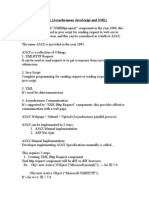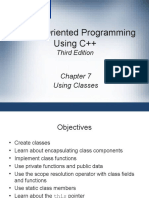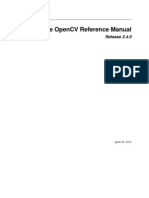Extensio N Require D Description: Global - Asax Controls Web Service
Extensio N Require D Description: Global - Asax Controls Web Service
Uploaded by
sunnyyy1986Copyright:
Available Formats
Extensio N Require D Description: Global - Asax Controls Web Service
Extensio N Require D Description: Global - Asax Controls Web Service
Uploaded by
sunnyyy1986Original Title
Copyright
Available Formats
Share this document
Did you find this document useful?
Is this content inappropriate?
Copyright:
Available Formats
Extensio N Require D Description: Global - Asax Controls Web Service
Extensio N Require D Description: Global - Asax Controls Web Service
Uploaded by
sunnyyy1986Copyright:
Available Formats
ASP.
NET
Extensio
n
Require
d
version
Description
asax 1.0 Global.asax, used for application-level logic
[14]
ascx 1.0 Web UserControls custo! controls to be placed onto "eb pages.
as#x 1.0 custo! $%%& #andlers.
as!x 1.0
"eb service pages. 'ro! version (.0 a Code be#ind page of an as!x )le
is placed into t#e app*code folder.
axd 1.0
"#en enabled in "eb.con)g re+uesting trace.axd outputs application-
level tracing. ,lso used for t#e special "ebresource.axd #andler "#ic#
allo"s control-co!ponent developers to pac.age a co!ponent-control
co!plete "it# i!ages, script, css etc. for deplo/!ent in a single )le 0an
1asse!bl/12
bro"ser (.0
bro"ser capabilities )les stored in 345 for!at6 introduced in version (.0.
,7&.89% ( includes !an/ of t#ese b/ default, to support co!!on "eb
bro"sers. %#ese specif/ "#ic# bro"sers #ave "#ic# capabilities, so t#at
,7&.89% ( can auto!aticall/ custo!i:e and opti!i:e its output
accordingl/. 7pecial .bro"ser )les are available for free do"nload to
#andle, for instance, t#e W;C <alidator, so t#at it properl/ s#o"s
standards-co!pliant pages as being standards-co!pliant. =eplaces t#e
#arder-to-use >ro"serCaps section t#at "as in !ac#ine.con)g and could
be overridden in "eb.con)g in ,7&.89% 1.x.
con)g 1.0
"eb.con)g is t#e onl/ )le in a speci)c Web application to use t#is
extension b/ default 0!ac#ine.con)g si!ilarl/ a?ects t#e entire Web
server and all applications on it2, #o"ever ,7&.89% provides facilities to
create and consu!e ot#er con)g )les. %#ese are stored in 345 for!at.
cs-vb 1.0
Code )les 0cs indicates C@, vb indicates <isual >asic2. Code be#ind )les
0see above2 predo!inantl/ #ave t#e extension A.aspx.csA or A.aspx.vbA
for t#e t"o !ost co!!on languages. Bt#er code )les 0often containing
co!!on Alibrar/A classes2 can also exist in t#e "eb folders "it# t#e
cs-vb extension. Cn ,7&.89% ( t#ese s#ould be placed inside t#e
,pp*Code folder "#ere t#e/ are d/na!icall/ co!piled and available to
t#e "#ole application.
db!l ;.D 5C8E to 7E5 data classes )le
!aster (.0 !aster page )le. Fefault )le na!e is 4aster1.!aster
resx 1.0 resource )les for internationali:ation and locali:ation. =esource )les can
be global 0e.g. !essages2 or AlocalA "#ic# !eans speci)c for a single
aspx or ascx )le.
site!ap (.0 site!ap con)guration )les. Fefault )le na!e is "eb.site!ap
s.in (.0 t#e!e s.in )les.
svc ;.0 Windo"s Co!!unication 'oundation service )le
ed!x ;.D ,FB.89% 9ntit/ 'ra!e"or. !odel
Describe the role of inetinfo.exe, aspnet_isapi.dll andaspnet_wp.exe in the page loading process.
inetinfo.exe is theMicrosoft IIS server running, handling ASP.N! re"uests a#ong other things.$hen an ASP.N!
re"uest is received %usuall& a file with .aspx extension', the ISAPI filter aspnet_isapi.dll ta(es care of it b& passing
the re"uest tothe actual wor(er process aspnet_wp.exe.
$hat)s the difference between *esponse.$rite%' and*esponse.+utput.$rite%',
*esponse.+utput.$rite%' allows &ou to write for#atted output.
$hat #ethods are fired during the page load,
Init%' - when the page is instantiated
.oad%' - when the page is loaded into server #e#or&
Pre*ender%' - the brief #o#ent before the page is displa&ed to the user as /!M.
0nload%' - when page finishes loading.
$hen during the page processing c&cle is 1iewState available,
After the Init%' and before the Page_.oad%', or +n.oad%' for a control.
$hat na#espace does the $eb page belong in the .N! 2ra#ewor( class hierarch&,
S&ste#.$eb.0I.Page
$here do &ou store the infor#ation about the user)s locale,
S&ste#.$eb.0I.Page.3ulture
$hat)s the difference between 3odebehind45M&3ode.aspx.cs5 andSrc45M&3ode.aspx.cs5,
3ode6ehind is relevant to 1isual Studio.N! onl&.
$hat data t&pes do the *ange1alidator control support,
Integer, String, and Date.
xplain the differences between Server-side and 3lient-side code,
Server-side code executes on the server. 3lient-side code executes in the client7s browser.
$hat t&pe of code %server or client' is found in a 3ode-6ehind class,
!he answer is server-side code since code-behind is executed on the server. /owever, during the code-behind7s
execution on the server, it can render client-side code such as 8avaScript to be processed in the clients browser. 6ut
9ust to be clear, code-behind executes on the server, thus #a(ing it server-side code.
$hat is the difference between Server.!ransfer and *esponse.*edirect, $h& would I choose one over the other,
Server.Transfer transfers page processing fro# one page directly to the next page without making a round-trip
ack to the client!s rowser. !his provides a faster response with a little less overhead on the server.
Server.!ransfer does not update the clients url history list or current url. *esponse.*edirect is used to redirect the
user7s browser to another page or site. !his perfor#as a trip bac( to the client where the client7s browser is
redirected to the new page. !he user7s browser histor& list is updated to reflect the new address.
$hat is the :lobal.asax used for,
!he :lobal.asax %including the :lobal.asax.cs file' is used to i#ple#ent application and session level events.
<%@ Application Language="C#" %>
<script runat="server">
void Application_Start(object sender !ventArgs e"
#
$$ Code t%at runs on application startup
&
void Application_!nd(object sender !ventArgs e"
#
$$ Code t%at runs on application s%utdo'n
&
void Application_!rror(object sender !ventArgs e"
#
$$ Code t%at runs '%en an un%andled error occurs
&
void Session_Start(object sender !ventArgs e"
#
$$ Code t%at runs '%en a ne' session is started
&
void Session_!nd(object sender !ventArgs e"
#
$$ Code t%at runs '%en a session ends(
$$ )ote* +%e Session_!nd event is raised onl, '%en t%e sessionstate -ode
$$ is set to .n/roc in t%e 0eb(con1ig 1ile( .1 session -ode is set to
StateServer
$$ or S2LServer t%e event is not raised(
&
<$script>
$hat are the Application_Start and Session_Start subroutines used for,
!his is where &ou can set the specific variables for the Application and Session ob9ects.
3an &ou explain what inheritance is and an exa#ple of when &ou #ight use it,
$hen &ou want to inherit %use the functionalit& of' another class. xa#ple; $ith a base class na#ed #plo&ee, a
Manager class could be derived fro# the #plo&ee base class.
Describe the difference between inline and code behind.
Inline code written alongside the ht#l in a page. 3ode-behind is code written in a separate file and referenced b& the
.aspx page.
$hats MSI., and wh& should #& developers need an appreciation of it if at all,
MSI. is the Microsoft Inter#ediate .anguage. All .N! co#patible languages will get converted to MSI.. MSI.
also allows the .N! 2ra#ewor( to 8I! co#pile the asse#bl& on the installed co#puter.
Na#e two properties co##on in ever& validation control,
3ontrol!o1alidate propert& and !ext propert&.
$hat are the validation controls in asp.net,
!o si#plif& developer)s life without writing code to validate the user input validation controls are
developed.ASP.N! validation controls also provide two wa&s of validation; Server-side or 3lient-side. !he nice
thing about these 1alidation controls is that it will perfor# client-side validation when it detects the browser is able
%unless client-side validation has been disabled'. !hus reducing roundtrips. And it will perfor# server-side where
necessar&. !his client-side<server-side detection and validation is done without extra wor( b& the developer=
$ith ASP.N!, there are six%>' controls included. !he& are;
!he *e"uired2ield1alidation 3ontrol; it #a(es sure that a user inputs a value.% attri;3ontrol!o1alidate'
!he 3o#pare1alidator 3ontrol ; it ensures the sa#e value b<n two controls , b<n a control and a fixed value. 0sage
of this 3o#pare1alidator is for confir#ing new passwords, chec(ing if a departure date is before the arrival date.
%attri;3ontrol!o1alidate,3ontrol!o3o#pare,1alue!o3o#pare,+perator'
!he *ange1alidator 3ontrol ; chec(s to see if a control value is within a valid range%attri; 3ontrol!o1alidate
,Maxi#u#1alue, Mini#u#1alue, and !&pe'
!he *egularxpression1alidator 3ontrol ; nsures that the value of an input control #atches a specified pattern.
%attri; 3ontrol!o1alidate, 1alidationxpression'ex;#ail validation.
!he 3usto#1alidator 3ontrol; adds great flexibilit& to our validation abilities./ere we get to write out own
functions and pass the control value to this function.%attri; 3ontrol!o1alidate, 3lient1alidation2unction,
+nServer1alidate'. $e notice that there are two new attributes 3lient1alidation2unction and +nServer1alidate.
3lient1alidation2unction is usuall& a 9avascript funtion included in the ht#l to the user. +nServer1alidate is the
function that is server-side to chec( for validation if client does not support client-side validation.
1alidation Su##ar& 3ontrol; an additional control that co#ple#ents the validation controls. !he validation
su##ar& control will collect all the error #essages of all the non-valid controls and put the# in a tid& list. !he list
can be either shown on the web page %ShowSu##ar&4?!rue?' or with a popup box %b& specif&ing
ShowMessage6ox45!rue5'
All of the validation controls inherit fro# the base class 6ase1alidator so the& all have a series of properties and
#ethods that are co##on to all validation controls. !he& are;
3ontrol!o1alidate - !his value is which control the validator is applied to.
rrorMessage - !his is the error #essage that will be displa&ed in the validation su##ar&.
Is1alid - 6oolean value for whether or not the control is valid.
1alidate - Method to validate the input control and update the Is1alid propert&.
Displa& - !his controls how the error #essage is shown. /ere are the possible options;
o None %!he validation #essage is never displa&ed.'
o Static %Space for the validation #essage is allocated in the page la&out.'
o D&na#ic %Space for the validation #essage is d&na#icall& added to the page if validation fails.'
Note; If &ou are doing server-side validation, #a(e sure the button onclic( #ethod has a Page.Is1alid if state#ent or
it will loo( li(e &our validators aren7t doing an&thing.
$hat is the transport protocol &ou use to call a $eb service,
S+AP %Si#ple +b9ect Access Protocol' is the preferred protocol.
!rue or 2alse; A $eb service can onl& be written in .N!,
2alse
$hat does $SD. stand for,
$eb Services Description .anguage.
$here on the Internet would &ou loo( for $eb services,
http;<<www.uddi.org
!rue or 2alse; !o test a $eb service &ou #ust create a $indows application or $eb application to consu#e this
service,
2alse, the web service co#es with a test page and it provides /!!P-:! #ethod to test.
$hat is the difference between /!!P-:! and /!!P-P+S!,
"ET and P#ST basicall& allow information to e sent ack to the we server from a rowser %or other /!!P
client for that #atter'. 3hoosing "ET as the 5#ethod5 will append all of the data in the form to the $%& and it
will show up in the $%& ar of your rowser .So it is not secured. !he a#ount of infor#ation &ou can send bac(
using a :! is restricted as $%&s can only e '()* characters. :! is the default #ethod used in the for# if not
#entioned. A P#ST on the other hand will %t&picall&' send the information through a soc(et %+essage ,ody'
bac( to the web server and it won!t show up in the $%& ar. So it is secured. @ou can send #uch #ore
infor#ation to the server this wa& - and it7s not restricted to textual data either.
$hat is State Manage#ent,
-TTP is a stateless protocol. State #anage#ent is the process b& which &ou #aintain state and page infor#ation
over #ultiple re"uests for the sa#e or different pages. !here are ) types State Manage#ent; 3lient A Side State
Manage#ent and Server A Side State Manage#ent.
3SSM stores infor#ation on the client7s co#puter b& e#bedding the infor#ation into a $eb page, a unifor#
resource locator %url', or a coo(ie.
.iew State A Asp.Net uses 1iew State to trac( the values in the 3ontrols. @ou can add custo# values to the view
state. It is used b& the Asp.net page fra#ewor( to auto#aticall& save the values of the page and of each control 9ust
prior to rendering to the page. $hen the page is posted, one of the first tas(s perfor#ed b& page processing is to
restore view state.
Advantages;
No server resources are re/uired !he view state is contained in a structure within the page code.
Simple implementation 1iew state does not re"uire an& custo# progra##ing to use. It is on b& default
to #aintain state data on controls.
Enhanced security features !he values in view state are hashed, co#pressed, and encoded for 0nicode
i#ple#entations, which provides #ore securit& than using hidden fields.
Disadvantages;
Performance considerations 6ecause the view state is stored in the page itself, storing large values can
cause the page to slow down when users displa& it and when the& post it. !his is especiall& relevant for
#obile devices, where bandwidth is often a li#itation.
0evice limitations Mobile devices #ight not have the #e#or& capacit& to store a large a#ount of view-
state data.
Potential security risks !he view state is stored in one or #ore hidden fields on the page. Although view
state stores data in a hashed for#at, it can still be ta#pered with. !he infor#ation in the hidden field can be
seen if the page output source is viewed directl&, creating a potential securit& issue
3ontrol State A If &ou create a custo# control that re"uires view state to wor( properl&, &ou should use control state
to ensure other developers don)t brea( &our control b& disabling view state.
Advantages;
No server resources are re/uired 6& default, control state is stored in hidden fields on the page.
%eliaility 6ecause control state cannot be turned off li(e view state, control state is a #ore reliable
#ethod for #anaging the state of controls.
.ersatility 3usto# adapters can be written to control how and where control-state data is stored.
Disadvantages;
Some programming is re/uired $hile the ASP.N! page fra#ewor( provides a foundation for control
state, control state is a custo# state-persistence #echanis#. !o full& utiliBe control state, &ou #ust write
code to save and load control state.
/idden fields A .i(e view state, hidden fields store data in an /!M. for# without displa&ing it in the user7s
browser. !he data is available onl& when the for# is processed.
Advantages;
No server resources are re/uired !he hidden field is stored and read fro# the page.
1idespread support Al#ost all browsers and client devices support for#s with hidden fields.
Simple implementation /idden fields are standard /!M. controls that re"uire no co#plex progra##ing
logic.
Disadvantages;
Potential security risks !he hidden field can be ta#pered with. !he infor#ation in the hidden field can
be seen if the page output source is viewed directl&, creating a potential securit& issue. @ou can #anuall&
encr&pt and decr&pt the contents of a hidden field, but doing so re"uires extra coding and overhead. If
securit& is a concern, consider using a server-based state #echanis# so that no sensitive infor#ation is sent
to the client. 2or #ore infor#ation, see ASP.N! $eb Application Securit& and 6asic Securit& Practices
for $eb Applications.
Simple storage architecture !he hidden field does not support rich data t&pes. /idden fields offer a
single string value field in which to place infor#ation. !o store #ultiple values, &ou #ust i#ple#ent
deli#ited strings and the code to parse those strings. @ou can #anuall& serialiBe and de-serialiBe rich data
t&pes to and fro# hidden fields, respectivel&. /owever, it re"uires extra code to do so. If &ou need to store
rich data t&pes on the client, consider using view state instead. 1iew state has serialiBation built-in, and it
stores data in hidden fields.
Performance considerations 6ecause hidden fields are stored in the page itself, storing large values can
cause the page to slow down when users displa& it and when the& post it.
Storage limitations If the a#ount of data in a hidden field beco#es ver& large, so#e proxies and
firewalls will prevent access to the page that contains the#. 6ecause the #axi#u# a#ount can var& with
different firewall and prox& i#ple#entations, large hidden fields can be sporadicall& proble#atic. If &ou
need to store #an& ite#s of data, consider doing one of the following;
Put each ite# in a separate hidden field.
0se view state with view-state chun(ing turned on, which auto#aticall& separates data into
#ultiple hidden fields.
Instead of storing data on the client, persist the data on the server. !he #ore data &ou send to the
client, the slower the apparent response ti#e of &our application will be because the browser will need to
download or send #ore data.
3oo(ies 1e applications can store small pieces of data in the client2s 1e rowser b& using coo(ies. A coo(ie
is a small amount of data that is stored either in a text file on the client file system %if the coo(ie is persistent' or
in #e#or& in the client browser session %if the coo(ie is te#porar&'. !he #ost co##on use of coo(ies is to identif&
a single user as he or she visits #ultiple $eb pages.
Advantages;
3onfigurale expiration rules !he coo(ie can expire when the browser session ends, or it can exist
indefinitel& on the client co#puter, sub9ect to the expiration rules on the client.
No server resources are re/uired !he coo(ie is stored on the client and read b& the server after a post.
You might also like
- PROJECT REPORT Travel ManagementDocument34 pagesPROJECT REPORT Travel Managementdsagar523050% (2)
- Robin Sarma - Budni U 5 PDFDocument2 pagesRobin Sarma - Budni U 5 PDFPero BradvicaNo ratings yet
- ASP.NET For Beginners: The Simple Guide to Learning ASP.NET Web Programming Fast!From EverandASP.NET For Beginners: The Simple Guide to Learning ASP.NET Web Programming Fast!No ratings yet
- Ajax (Asynchronous Javascript and XML)Document4 pagesAjax (Asynchronous Javascript and XML)Sangeetha BajanthriNo ratings yet
- Web Service WorkshopDocument16 pagesWeb Service WorkshoprguptamtechNo ratings yet
- Enhancements in Powercenter 8 6 To 8 5Document14 pagesEnhancements in Powercenter 8 6 To 8 5saprsa1No ratings yet
- Online Voting System A ASP Net ProjectDocument47 pagesOnline Voting System A ASP Net Projectspatade7No ratings yet
- Windows Forms Programming in CDocument564 pagesWindows Forms Programming in CMelinte AlexandraNo ratings yet
- .Cs2358 Internet Programming LabDocument20 pages.Cs2358 Internet Programming LabHussain BibiNo ratings yet
- ASP.NetDocument20 pagesASP.NetMadhu DayakarNo ratings yet
- Chatlog 2-22-14 To 4 - 27 - 14 - Weekend Performance Tuning - Analyzing With DBA Skillsets - Every Sat - Sun 10 - 00 Am To 5 - 00 PM 2014-04-19 13 - 58Document2 pagesChatlog 2-22-14 To 4 - 27 - 14 - Weekend Performance Tuning - Analyzing With DBA Skillsets - Every Sat - Sun 10 - 00 Am To 5 - 00 PM 2014-04-19 13 - 58KamilarustamNo ratings yet
- List Members List Members Catch Automatic Code GenerationDocument87 pagesList Members List Members Catch Automatic Code GenerationRajanibtechcs CsiNo ratings yet
- A. Item InteroperationDocument14 pagesA. Item InteroperationliagsNo ratings yet
- Attacking AntivirusDocument21 pagesAttacking AntivirussssbulbulNo ratings yet
- Vcs GuideDocument34 pagesVcs GuideprincekhnNo ratings yet
- ASP Net NotesDocument15 pagesASP Net NotesGoutami PeralaNo ratings yet
- The Common Language RuntimeDocument38 pagesThe Common Language Runtimearun.saivarajan2917No ratings yet
- What's New in Interaction Center With SAP CRM 7.0 EHP1Document2 pagesWhat's New in Interaction Center With SAP CRM 7.0 EHP1Ajit SinhaNo ratings yet
- Interview QuestionDocument6 pagesInterview QuestionBhawna UtrejaNo ratings yet
- Remote Approach For Effective Task Executin and Data Accessing ToolDocument48 pagesRemote Approach For Effective Task Executin and Data Accessing ToolWong Kai WeiNo ratings yet
- Kalyan New ResumeDocument6 pagesKalyan New ResumeRyan BrownNo ratings yet
- Pascal NotesDocument51 pagesPascal Notesdnlkaba0% (1)
- Windows Powershell 2.0 Brings Scripting To Active Directory - and Not Just For Windows Server 2008 R2Document3 pagesWindows Powershell 2.0 Brings Scripting To Active Directory - and Not Just For Windows Server 2008 R2Ramya RameshNo ratings yet
- ActiveX ScriptingDocument37 pagesActiveX ScriptingSourav BebartaNo ratings yet
- Apache CXF and Axis2 Web ServicesDocument41 pagesApache CXF and Axis2 Web ServicesRavikumar TumuluriNo ratings yet
- V&V V&V V&V V&V: Requirements Engineering VV RequirementsDocument107 pagesV&V V&V V&V V&V: Requirements Engineering VV RequirementshadjNo ratings yet
- Unit1 Od C/s ComputingDocument10 pagesUnit1 Od C/s ComputingKannan KumaranNo ratings yet
- Q: What Is A Performance Test PlanDocument3 pagesQ: What Is A Performance Test Planshanthan117No ratings yet
- Load Runner TrainingDocument16 pagesLoad Runner TrainingRakesh Reddy GeetlaNo ratings yet
- CWND::: GetparentDocument7 pagesCWND::: GetparentMadhavi Chandrakant SawantNo ratings yet
- 1000 SAP ABAP Interview QuesDASDions and AnswersDocument19 pages1000 SAP ABAP Interview QuesDASDions and AnswersSreenith SathianNo ratings yet
- Robot : Public Class Robot ExtendsDocument5 pagesRobot : Public Class Robot ExtendsRizky AkbarNo ratings yet
- 1 What Are The Major Differences Between ESX 3.5 and Vsphere?Document8 pages1 What Are The Major Differences Between ESX 3.5 and Vsphere?ramesh2440No ratings yet
- Brahmini - Java ConsultantDocument5 pagesBrahmini - Java ConsultantsuniltecreosNo ratings yet
- Pascal NotesDocument50 pagesPascal NotesdnlkabaNo ratings yet
- Hibernate (An ORM Tool)Document69 pagesHibernate (An ORM Tool)ali khanNo ratings yet
- Conversion of IDOC's To XML FormatDocument3 pagesConversion of IDOC's To XML FormatRakesh RaiNo ratings yet
- SQL Server Interview Questions: Explain The Use of Keyword WITH ENCRYPTION. Create A Store Procedure With EncryptionDocument10 pagesSQL Server Interview Questions: Explain The Use of Keyword WITH ENCRYPTION. Create A Store Procedure With EncryptionRicardo Aranibar LeonNo ratings yet
- Certified C# Professional VS-1066Document0 pagesCertified C# Professional VS-1066Vskills CertificationNo ratings yet
- WTOPCSvrDocument20 pagesWTOPCSvrPedro PradoNo ratings yet
- QA Interview FAQDocument318 pagesQA Interview FAQPraveen Kumar GogulaNo ratings yet
- (Software Design Specification) : CS 4500, University of Utah Spring 2006Document14 pages(Software Design Specification) : CS 4500, University of Utah Spring 2006Najmul HasanNo ratings yet
- Introduction To Javascript: What You Should Already KnowDocument54 pagesIntroduction To Javascript: What You Should Already KnowsauvishNo ratings yet
- Process Overview: Object-Oriented Modeling and DesignDocument4 pagesProcess Overview: Object-Oriented Modeling and DesignparimalamailboxNo ratings yet
- Guide To Snare For Linux-4.0Document28 pagesGuide To Snare For Linux-4.0Pamungkas SigidNo ratings yet
- Analyzing SharePoint UsageDocument23 pagesAnalyzing SharePoint UsageAlkenshin100% (1)
- VB Script For QTP: I) IntroductionDocument31 pagesVB Script For QTP: I) IntroductionatulsinghchouhanNo ratings yet
- Ins and Outs of Oscilloscope Programming: Examples in C and Microsoft Visual BasicDocument6 pagesIns and Outs of Oscilloscope Programming: Examples in C and Microsoft Visual BasicparisalitopanNo ratings yet
- 1.1 Control Module RequirementsDocument70 pages1.1 Control Module RequirementsShivani Ekant YadavNo ratings yet
- SMS BlockDocument65 pagesSMS BlockbhagathchethanNo ratings yet
- Autostructure - The Easy Way To Create The Internal Structure of Your ShipDocument17 pagesAutostructure - The Easy Way To Create The Internal Structure of Your ShipSetyo ThreebNo ratings yet
- Using Linq To SQLDocument115 pagesUsing Linq To SQLGaston SanchezNo ratings yet
- Testing ToolsDocument51 pagesTesting Toolsmurthy_oct24No ratings yet
- What Is Auto Invoice in OM Module?what Is Use of It?: InterfaceDocument7 pagesWhat Is Auto Invoice in OM Module?what Is Use of It?: Interfaceparvathi12No ratings yet
- BC420 - 46C - 008legacy System Migration Workbench (LSMW)Document70 pagesBC420 - 46C - 008legacy System Migration Workbench (LSMW)mkumarshahi100% (1)
- Java Is An ObjectDocument44 pagesJava Is An ObjectkunkumabalaNo ratings yet
- Inurance Agent Application System Full Doc - J-KarthikaDocument28 pagesInurance Agent Application System Full Doc - J-KarthikaPraveen CoolNo ratings yet
- Segments Form The Basic Building Blocks of An Idoc Type and Are UsedDocument11 pagesSegments Form The Basic Building Blocks of An Idoc Type and Are UsedNarayanaNo ratings yet
- Ian Talks JavaScript Libraries and Frameworks A-Z: WebDevAtoZ, #4From EverandIan Talks JavaScript Libraries and Frameworks A-Z: WebDevAtoZ, #4No ratings yet
- Object Oriented ApproachDocument28 pagesObject Oriented ApproachGlobal AccessNo ratings yet
- Ec1102n - Mimi Nur Nabila Binti Alias - 2019293128 - Final ExamDocument17 pagesEc1102n - Mimi Nur Nabila Binti Alias - 2019293128 - Final ExammimiNo ratings yet
- Object-Oriented Programming Using C++: Third EditionDocument33 pagesObject-Oriented Programming Using C++: Third EditionAnshuman DwivediNo ratings yet
- Notes For Centres 2106Document7 pagesNotes For Centres 2106Kza1No ratings yet
- No Code Meme BookDocument36 pagesNo Code Meme BookvijupalakkatNo ratings yet
- Video Library Management System Project ReportDocument118 pagesVideo Library Management System Project ReportAkash ModakNo ratings yet
- LiteCAD ReferenciaDocument36 pagesLiteCAD Referenciacrls_marcosNo ratings yet
- AstroShock PPT by Debottam Mukherjee FinalDocument9 pagesAstroShock PPT by Debottam Mukherjee Finalssmukherjee2013No ratings yet
- 01 Angular Architecture MonoRepoDocument73 pages01 Angular Architecture MonoRepoBhak bokachodaNo ratings yet
- 1-W23 RW Student GuideDocument162 pages1-W23 RW Student Guidemaruthi63No ratings yet
- Fortinet Webinar - FortiADC - Phai La Quy (Sep17,21)Document22 pagesFortinet Webinar - FortiADC - Phai La Quy (Sep17,21)dasker NoNo ratings yet
- Monte CarloDocument6 pagesMonte Carlovvaswin2004No ratings yet
- Types of Digital DataDocument26 pagesTypes of Digital DataPonnusamy S PichaimuthuNo ratings yet
- Unit-05 SSB DBMSDocument174 pagesUnit-05 SSB DBMSAayush KumarNo ratings yet
- Solidworks Essentials CourseDocument2 pagesSolidworks Essentials CourseMohamad Haziq Mohamad ZinNo ratings yet
- LTK - A Lisp Binding To The TK Toolkit: Peter Herth February 5, 2006Document65 pagesLTK - A Lisp Binding To The TK Toolkit: Peter Herth February 5, 2006Yordan Sullca PalominoNo ratings yet
- GoodElearning TOGAF Poster 44 - ToGAF and ArchiMateDocument1 pageGoodElearning TOGAF Poster 44 - ToGAF and ArchiMateFabian HidalgoNo ratings yet
- ABAP Performance TuningDocument40 pagesABAP Performance Tuningapp bundleNo ratings yet
- JpdaDocument13 pagesJpdaRavi Kumar PinnaboyinaNo ratings yet
- Powershell Day1Document84 pagesPowershell Day1nikesdaNo ratings yet
- JVM Internals & Runtime Data AreasDocument13 pagesJVM Internals & Runtime Data AreaskannangceNo ratings yet
- September 2019 Cycle (Resit) Key Dates BSC in Computing/Ethical (September 2019) - CourseworkDocument2 pagesSeptember 2019 Cycle (Resit) Key Dates BSC in Computing/Ethical (September 2019) - CourseworkNirajan BasnetNo ratings yet
- Learning SQLite For iOS - Sample ChapterDocument25 pagesLearning SQLite For iOS - Sample ChapterPackt PublishingNo ratings yet
- Of Installation OpenFOAMv9 v2106 WindowsDocument4 pagesOf Installation OpenFOAMv9 v2106 WindowsDebendra Nath SarkarNo ratings yet
- E10 CommonWebSphereESBPatternsChoicesDocument46 pagesE10 CommonWebSphereESBPatternsChoicesDinesh SubramanianNo ratings yet
- Important Questions XII Computer Science CBSEDocument16 pagesImportant Questions XII Computer Science CBSEbaabisoorajNo ratings yet
- Udomctf Memory Forensics ChallengesDocument11 pagesUdomctf Memory Forensics ChallengesDAVID MGAYANo ratings yet
- Computer Science PracticalDocument43 pagesComputer Science PracticalVaibhav ChandraNo ratings yet
- Opencv 2 RefmanDocument643 pagesOpencv 2 RefmanjayneildalalNo ratings yet

























































































